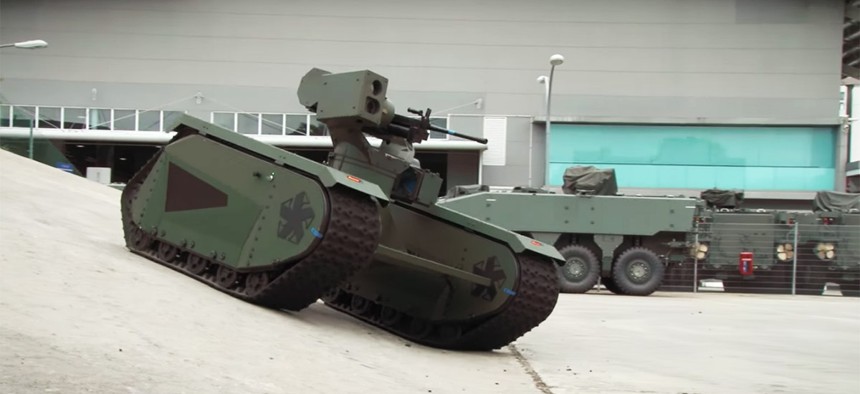Beyond Big Dog: The US Army Searches for an Infantry Squadbot

The Titan unmanned ground vehicle by Milrem and QinetiQ North America Milrem/YouTube
Service officials have a concept of operations and a plan to deploy a cargo-carrying robot alongside dismounted soldiers in 2019. But can the acquisition system keep up?
Robot makers from around the world are in Washington, D.C., this week to answer the U.S. Army’s call for machines that can roll alongside a dismounted squad to carry gear, watch the flank, or possibly even wield a machine gun. But one manufacturer says that unless the service fixes the way it supplies the infantry with technology, it’ll never catch up to the commercial sector.
Army officials, who call their prospective cargo robot the Squad Multi-Purpose Equipment Transport, want it to keep up with soldiers on foot for 72 hours without refueling; and to operate autonomously, semi-autonomously (think waypoint navigation or wireless leader-follower), and by remote control. They are already testing early prototypes and hope to deploy the new robot in 2019.
Among the robot builders who will show their wares at the Association of the United States Army’s convention downtown is General Dynamics Land Systems. The company’s Multipurpose Unmanned Tactical Transport, or MUTT, is built to carry up to 600 pounds of gear — or a .50-caliber machine gun, meant to be “a way to provide the troops with more firepower,” GDLS’ Dan Rodgers. He says the MUTT is amphibious, can fit on any transport platform, and can can be airdropped with soldiers. The company says that it’s already sold 29 MUTTs to the Marine Corps.
AUSA will also see the launch of a new entry in the S-METcontest, from Millrim and QinetiQ North America, who call theirTitan the “first fully modular, hybrid unmanned ground vehicle” to meet the program’s initial requirements.
It’s a robot platform in the most literal sense, a metal shelf slung between two tank treads, ready to carry a gun turret, cargo container, or any of a wide variety of payloads.
The plan to deploy robots like Titan and MUTT alongside soldiers by 2019 suggests that the future has finally arrived. But for those of us who recall the 2008 hype over the Big Dog platform, it all feels a bit familiar.
The Big Dog, built by robotics maker Boston Dynamics with funding from the Defense Advanced Research Projects Agency, or DARPA, was supposed to change warfare forever. It could sit, stand, walk, and maintain its balance even as engineers tried to kick it over, to the continued delight of millions of YouTube watchers. But the Marines judged the gas-powered robot too noisy, and shelved it last year.
Poised for Rollout
Endeavor Robotics CEO Sean Bielat thinks dismounted robots are finally poised to become battlefield reality. (Endeavor is a spinoff of iRobot, the company that sells the Packbot bomb-disposal robot made famous by “The Hurt Locker.”) One reason, Bielat says, is that the military has figured out how dismounted robots might work with the infantry.
“It takes a while for the conops [concept of operations] and tactics, techniques, procedures that support new technology to be developed and optimized for use at the infantry level,” he said.
The Army will spell out its new concept of operations for ground robots in its forthcoming Robotic and Autonomous Systems Strategy.
But even as doctrinal hurdles are disappearing, obstacles created by the acquisition system persist. The problem, as Bielat sees it, is that that the military buys technology for the infantry too much the same way it buys much pricier items like jets: with lots of specialized requirements, red tape and an overabundance of caution. That makes sense, in theory, when you’re buying airplanes made in 46 states, but not when you’re buying small electronics for the infantry.
“You look at the Air Force and how they do development, you’re looking at capital-intensive systems where the next generation is planned out 20 years prior to its fielding. You’re looking at the 6th-generation fighters just as the 5th generation is getting out the gate. Infantry doesn’t work like that. The average cost of an item that is deployed at an infantry squad level is very low,” he says.
The Army has created initiatives like the Rapid Equipping Force to help bypass that bureaucracy and meet “urgent” soldier requirements, but the REF is also a tacit acknowledgement that the military does not generally equip rapidly.
Contrast that with the consumer electronics industry, which excels at rolling out new products at competitive prices to international markets within two years. Upgrades appear much more quickly. And don’t kid yourself, robots are electronics with wheels or legs.
“If you look at the pace of innovation in the commercial sector, it drastically outpaces the pace of innovation in defense. At the small-robot level, we would like to take advantage of some of the innovations out, there but we are constrained,” Bielat said. “There’s a lot of good people working really hard within the government trying to do acquisitions right. The system that we have is slow and cumbersome. It’s a disservice to the war fighter and I know that a lot of the people that are working through these acquisitions processes are frustrated as well.”
He says the process of creating a military program of record is too slow and cumbersome.
“I think the reason Big Dog did not move forward was because there wasn’t a program for it, not because the technology failed,” he says.
Bottom line: “I don’t think you’ll see huge advances in the small ground robots space within the defense sector in the next five years,” he said. “We are focused, right now, on defense and we see great opportunities there. We think that we can do very well in providing capabilities to support the warfighter but we also see, over the next 18 to 24 months, opportunities in commercial and industrial, and in some ways, those may move more quickly.”






